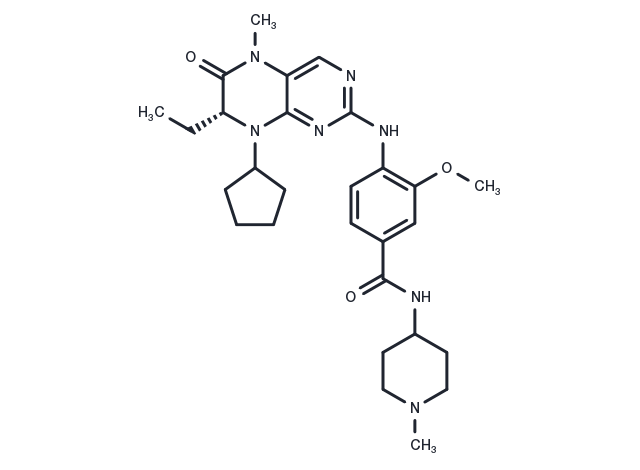Powder: -20°C for 3 years | In solvent: -80°C for 1 year


BI2536 is an effective Plk1 inhibitor (IC50: 0.83 nM). It has 4- and 11-fold greater selectivity than Plk2 and Plk3.

| Pack Size | Availability | Price/USD | Quantity |
|---|---|---|---|
| 1 mg | In stock | $ 38.00 | |
| 2 mg | In stock | $ 54.00 | |
| 5 mg | In stock | $ 89.00 | |
| 10 mg | In stock | $ 105.00 | |
| 25 mg | In stock | $ 126.00 | |
| 50 mg | In stock | $ 207.00 | |
| 100 mg | In stock | $ 369.00 | |
| 500 mg | In stock | $ 885.00 | |
| 1 mL * 10 mM (in DMSO) | In stock | $ 98.00 |





| Description | BI2536 is an effective Plk1 inhibitor (IC50: 0.83 nM). It has 4- and 11-fold greater selectivity than Plk2 and Plk3. |
| Targets&IC50 | PLK3:9 nM (cell free), PLK1:0.83 nM (cell free), PLK2:3.5 nM (cell free) |
| In vitro | BI 2536 inhibits Plk1 enzyme activity at low nanomolar concentrations. The compound potently causes a mitotic arrest and induces apoptosis in human cancer cell lines of diverse tissue origin and oncogenome signature [1]. On treatment with nanomolar doses of BI 2536, ATC cells progressed normally through S phase but died thereafter, directly from mitotic arrest. Nontransformed thyroid cells were 3.2- to 18.4-fold less susceptible to BI 2536-induced cell cycle effects compared with ATC cells [2]. |
| In vivo | BI 2536 inhibits growth of human tumor xenografts in nude mice and induces regression of large tumors with well-tolerated intravenous dose regimens. In treated tumors, cells arrest in prometaphase, accumulate phosphohistone H3, and contain aberrant mitotic spindles [1]. |
| Kinase Assay | Recombinant human Plk1 (residues 1–603) was expressed as N-terminal, GST-tagged fusion protein with a baculoviral expression system and purified by affinity chromatography with Glutathione-agarose. Enzyme activity assays for Plk1, Plk2, and Plk3 were performed in the presence of serially diluted inhibitor with 20 ng of recombinant kinase and 10 μg casein from bovine milk as the substrate. Kinase reactions were performed in a final volume of 60 μl for 45 min at 30C (15 mM MgCl2, 25 mM MOPS [pH 7.0], 1 mM DTT, 1% DMSO, 7.5 μM ATP, 0.3 μCi g-P33-ATP). Reactions were terminated by the addition of 125 μl of ice-cold 5% TCA. After transfer of the precipitates to MultiScreen mixed ester cellulose filter plates, plates were washed with 1% TCA and quantified radiometrically. Dose-response curves were used for calculating IC50 values [1]. |
| Cell Research | Cell proliferation assays were performed by incubation in the presence of various concentrations of BI 2536 for 72 hr, and cell growth was assessed by the measurement of Alamar Blue dye conversion in a fluorescence spectrophotometer. Effective concentrations at which cellular growth was inhibited by 50% (EC50) were extrapolated from the dose-response curve fit [1]. |
| Animal Research | Female BomTac:NMRI-Foxn1nu mice were grafted subcutaneously with HCT 116 colon-carcinoma, NCI-H460, or A549 lung carcinoma cells by subcutaneous injection, respectively, of 2 × 10^6, 1 × 10^6, and 1 × 10^7 cells into the flank of each mouse. When tumors reached a volume of approximately 50 mm^3, animals were pair-matched into treatment and control groups of ten mice each. In regression experiments, treatment was not initiated until the mean tumor volume reached 500 mm^3. BI 2536 was formulated in hydrochloric acid (0.1 N), diluted with 0.9% NaCl, and injected intravenously into the tail vein at the indicated dose and schedule. The administration volume was 10 ml per kg body weight. Tumor volumes were determined three times a week with a caliper. The results were converted to tumor volume (mm^3) by the following formula: length × width2 × π/6. The weight of the mice was determined as an indicator of tolerability on the same days. For statistical analysis, the treatment group was compared with the vehicle control group in a one-sided (decreasing) exact Wilcoxon test [1]. |
| Molecular Weight | 521.65 |
| Formula | C28H39N7O3 |
| CAS No. | 755038-02-9 |
Powder: -20°C for 3 years | In solvent: -80°C for 1 year
H2O: < 1 mg/mL (insoluble or slightly soluble)
Ethanol: 93 mg/mL (178.3 mM)
DMSO: 20 mg/mL (38.3 mM)
You can also refer to dose conversion for different animals. More
bottom
Please see Inhibitor Handling Instructions for more frequently ask questions. Topics include: how to prepare stock solutions, how to store products, and cautions on cell-based assays & animal experiments, etc.
BI 2536 755038-02-9 Apoptosis Cell Cycle/Checkpoint Chromatin/Epigenetic Epigenetic Reader Domain PLK BI-2536 Inhibitor BI2536 inhibit Polo-like Kinase (PLK) inhibitor
